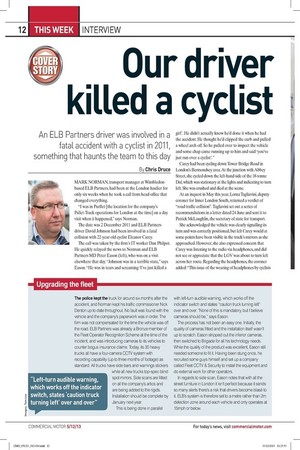pgra mg t e eet
Page 8

If you've noticed an error in this article please click here to report it so we can fix it.
The police kept the truck for around six months after the accident, and Norman kept his traffic commissioner Nick Denton up to date throughout. No fault was found with the vehicle and the company's paperwork was in order. The firm was not compensated for the time the vehicle was off the road. ELB Partners was already a Bronze member of the Fleet Operator Recognition Scheme at the time of the incident, and was introducing cameras to its vehicles to counter bogus insurance claims. Today, its 30 heavy trucks all have a four-camera CCTV system with recording capability (up to three months of footage) as standard. All trucks have side bars and warnings stickers
while all new trucks top-spec blind spot mirrors. Side scans are fitted on all the company's adios and are being added to the rigids. Installation should be complete by January next year. This is being done in parallel
with left-turn audible warning, which works off the indicator switch and states "caution truck turning left" over and over. "None of this is mandatory, but I believe cameras should be," says Eason.
The process has not been an easy one. Initially, the quality of cameras fitted and the installation itself wasn't up to scratch. Eason stripped out the inferior cameras, then switched to Brigade for all his technology needs. While the quality of the product was excellent, Eason still needed someone to fit it. Having been stung once, he recruited some guys himself and set up a company called Fleet CCTV & Security to install the equipment and do external work for other operators.
In regards to side scan, Eason notes that with all the street furniture in London it isn't perfect because it sends so many alerts there's a risk that drivers become blasé to it. ELB's system is therefore set to a metre rather than 2m detection zone around each vehicle and only operates at 15mph or below.




































